List of British Rail modern traction locomotive classes
This page lists every locomotive allocated a TOPS classification and all modern traction (e.g. diesel, electric, gas turbine, petrol) stock used on the mainline network since 1948 (i.e. British Railways and post-privatisation).
Diesel locomotives
The 1955 diesel locomotive classes are given in brackets where applicable.
A large number of different shunter types were purchased by British Rail and its predecessors, many of which were withdrawn prior to the introduction of TOPS. The tables below attempt to list the different types and the different classifications used to describe them as clearly as possible:
Small shunters: under 300 hp
Shunter classes are listed by 1955 class, which puts TOPS classes in ascending order, and generally puts 1948 and 1962 classes in ascending order. Unclassed shunters are placed at the start of the table; TOPS class 07 has been placed so its 1962 class is in the logical place.
| TOPS Class | 1948 Class | 1955 Class | 1962 Class | 1948 Numbers | 1957 Numbers | Year(s) built |
Quantity built |
Engine | Year(s) withdrawn |
Notes | Image |
|---|---|---|---|---|---|---|---|---|---|---|---|
| — | — | — | — | 11104 | 1950 | 1 | 52 hp ("At rail:" 39 hp) | 1967 | Renumbered 52 in the ER/NER Departmental series in 1953.[1] | ||
| — | — | — | — | 13000 | — | 1934 | 1 | 250 hp | 1949 | BR number never applied [2] | |
| — | DY1 | D1/1 | 1/15 | 11500–11502 | D2950–D2952 | 1954–55 | 3 | 153 bhp | 1966–67 | [3][4] | |
| Class 01 | DY2 | D1/2 | 1/12 | 11503–11506, 81 | D2953–D2956, D2956 (ii) | 1956–58 | 5 | 153 hp | 1966–81 | [5][3][6] |  |
| — | DY5 | D1/3 | 1/16 | 11507–11508 | D2957–D2958 | 1956 | 2 | 165 bhp | 1967–68 | [3][6] | |
| Class 02 | — | D1/4 | 1/17 | — | D2850–D2869 | 1960–61 | 20 | 170 hp | 1969–75 | [7][8] | 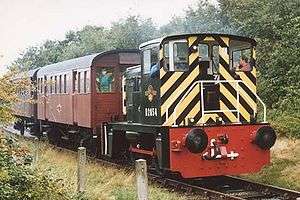 |
| — | DY11 | D2/1 | 2/4A | 11700–11707 | D2700–D2707 | 1953–56 | 8 | 200 bhp | 1964–68 | [9] | |
| Class 03 | DJ15 | D2/2 | 2/1 | 11187–11211 | D2000–D2199 D2370–D2399 |
1957–61 | 230 | 204 hp | 1968–93 2008 | [5][10] |  |
| Class 04 | DJ12/1 | D2/4 | 2/13 | 11100–11115 | D2200–D2214 | (D2289 1948) 1952-62 |
142 | 204 hp | 1967–72 | [5][11] D2289 still in use in Italy | 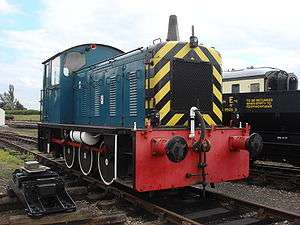 |
| DJ12/2 | D2/13 | 2/13 | 11121–11229 | D2215–D2341 | |||||||
| — | DJ14 | D2/5 | 2/12A | 11177–11186 | D2400–D2409 | 1956–57 | 10 | 204 bhp | 1967–69 | [12] | |
| — | — | D2/7 | 2/14 | 11116–20, 11144–48 | D2500–D2509 | 1955–56 | 10 | 204 bhp | 1967 | [13] | 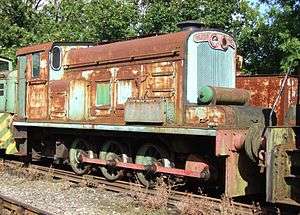 |
| Class 05 | DJ13 | D2/8 | 2/15A | 11136–43, 11161–76 | D2550–D2573 | 1955–61 | 69 | 204 hp | 1966–68, 1983 | [5][14] |  |
| DJ13/2 | D2/9 | 2/15 | — | D2574–D2618 | |||||||
| Class 06 | — | D2/6 | 2/12 | — | D2410–D2444 | 1958–60 | 35 | 204 hp | 1967–84 | [5][12] | 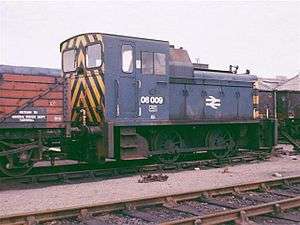 |
| — | DY11 | D2/10 | 2/4 | 11708–11719 | D2708–D2719 | 1957 | 12 | 225 bhp | 1967 | [15] [16] | |
| 2/4B | — | D2720–D2780 | 1958–61 | 61 | 225 bhp | 1967–68 | |||||
| — | — | D2/11 | 2/2 | — | D2999 | 1958 | 1 | 180 bhp | 1967 | [17][15] | |
| — | — | D2/12 | 2/14A | — | D2510–D2519 | 1961 | 10 | 204 bhp | 1967 | [18][13] | |
| Class 07 | — | — | 2/16 | — | D2985–D2998 | 1962 | 14 | 275 hp | 1973–Present Day D2991 (07007 Still in use at Eastleigh Works) | [5][19] | _shunter_at_Eastleigh.jpg) |
| — | — | D3/1 | 3/4 | — | D2900–D2913 | 1958–59 | 14 | 330 bhp | 1967 | [20][4] |
Large shunters: 300–799hp
| CLASS | NUMBERS | Built | Quantity | Engine | Withdrawn | Image | ||||
|---|---|---|---|---|---|---|---|---|---|---|
| TOPS | 1948 | 1955 | 1962 | 1948 | 1957 | |||||
| 15107 | 1949 | 1 | 360bhp | 1958[22] | ||||||
| 11001 | 1949 | 1 | 500bhp | 1959[23] | 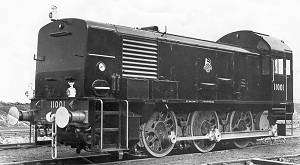 | |||||
| Class 08 | DEJ4 | D3/2 | 3/1 | 13000–13366 | D3000–D4192[24] except those listed under classes 09 and 10 |
1953[25]–62[24] | 996 | 350bhp | still in use[24] | |
| Class 09 | D3665–71, D3719–21, D4099–D4114 |
1959–62[24] | 26 | 350bhp | still in use[24] |  | ||||
| D3/3 | 3/1B | 13117–13126 | D3117–D3126 | 1955 | 10 | 350bhp | 1966–67[26] | |||
| Class 10 | DEJ5 | D3/4 | 3/1C | 13137–13151[27] | D3137–D3151, D3439–D3453, D3473–D3502, D3612–D3651, D4049–D4094 |
1955–62[27] | 146 | 350bhp | 1967–72[28] | |
| DEJ7 | D3/5 | 3/1D | 13152–13166 | D3152–D3166 | 1955 | 15 | 350bhp | 1967[26] | ||
| D3/6 | 12000–12002 | 1935 | 11 | 350bhp | 1956–62[29] | |||||
| D3/7 | 3/8 | 12003–12032 | 1939–42 | 30 | 350bhp | 1966–67[30] | ||||
| Class 11 | DEJ3 | D3/8 | 3/8A | 12033–12138 | 1945–52 | 136 | 350bhp | 1967–72[31] | 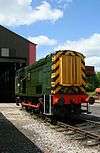 | |
| DEJ1 | D3/9 | 3/10 | 15000–15003 | 1944 | 4 | 350bhp | 1967[22] | |||
| D3/10 | 3/11A | 15100 | 1936 | 1[21] | 350bhp | 1965[23] | ||||
| D3/11 | 3/11 | 15101–15106 | 1948 | 6 | 350bhp | 1967[23] | ||||
| D3/12 | 3/9A | 15201–15203 | 1937 | 3 | 350bhp | 1964[23] | ||||
| Class 12 | D3/13 | 3/9 | 15211–15236 | 1949–52 | 24 | 350bhp | 1968–71[23] | 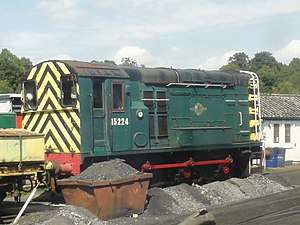 | ||
| DEJ2 | D3/14 | 3/2 | 15004 | 1949 | 1[21] | 360bhp | 1962 | |||
| Class 13 | 7/1 | D4500–D4502 | 1965 | 3[21] | 360bhp | 1983–1985 | 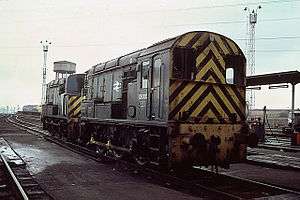 | |||
Type 1 locomotives: 800 - 1000hp
| CLASS | 1957 numbers | Introduced | Quantity | Engine | Withdrawn | Image | ||
|---|---|---|---|---|---|---|---|---|
| TOPS | 1955 | 1962 | ||||||
| Class 14 | 6/1 | D9500–D9555 | 1964-65 | 56 | 700 hp | 1968-69[32] |  | |
| 10800 | 1950[33] | 1[33] | 827 hp (rebuilt to 1400 hp) | 1959[33] | ||||
| Class 15 | D8/1 | 8/5 | D8200-D8243 | 1957-61[21] | 44[34] | 800hp | 1968-71 |
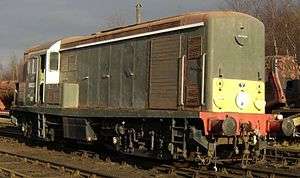 |
| Class 16 | D8/2 | 8/4[35] | D8400-D8409[35] | 1958[36] | 10[35] | 800 hp | 1968[35] | .jpg) |
| Class 17 | N/A | 9/18 | D8500-D8587 | 1962-65[37] | 117[37] | 450hp | 1968-71[37] | 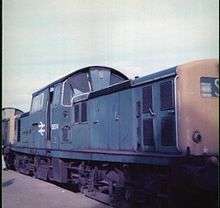 |
| 9/19 | D8588-D8616 | |||||||
| Class 18 | 1985 (Proposed) | Never Built | ||||||
| Class 19 | 2018 | 1 | DVT | still in use | 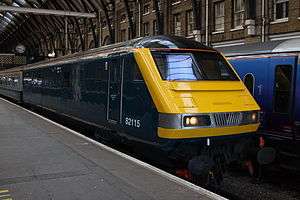 | |||
| Class 20 | D10/3 | 10/3[38] | D8000-199, D8300-27[39] | 1957-68[39] | 228[37] | 1000hp | still in use[24] |  |
Type 2 locomotives: 1001 - 1499hp
Locomotive class are listed by TOPS class. Locomotives for TOPS classes 24 and 26 have their original sub-classes shown, as each wholly comprised locomotives from a distinct 1962 class. Class 21 (II) has sub-classes shown as these are superficially similar but mechanically different types grouped into a single class.
| CLASS | 1957 numbers | Introduced | Quantity | Withdrawn | Image | |||
|---|---|---|---|---|---|---|---|---|
| TOPS | 1955 | 1962 | ||||||
| Class 21 (I) (NBL) | D10/1 | 10/4 | D6100-D6157 | 1958-60[36] | 58 | 1967-68 | 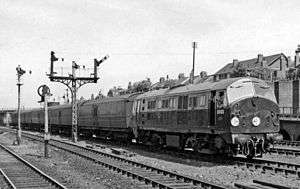 | |
| D11/2 | 11/4 | |||||||
| Class 21 (II) | 21/5 | N/A | N/A | N/A | 2004-05 | 4 | still in use | 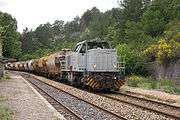 |
| 21/6 | 2006 | 2 | ||||||
| 21/9 | 1991-92 | 5 | 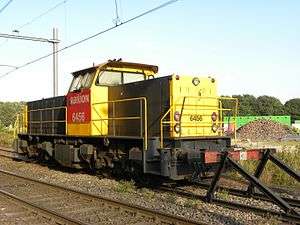 | |||||
| 2010 | 2 | |||||||
| 2016 | 3 | |||||||
| Class 22 (Baby Warship) | D10/2A | 10/4A | D6300-D6305 | 1959-62[36] | 58[40] | 1967-72[40] |  | |
| D11/5 | 11/4A | D6306-D6357 | ||||||
| Class 23 (Baby Deltic) | D11/1 | 11/3 | D5900-D5909 | 1959[36] | 10 | 1968-71 | 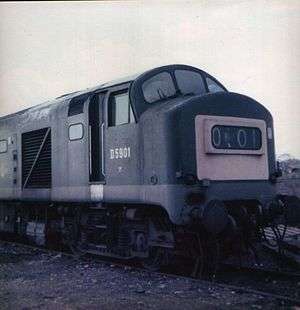 | |
| Class 24 | 24/0 | 11/1 | D5000-D5049 | 1958-61[36] | 50 | 1967-80 | ||
| 24/1 | D11/3 | 11/1A | D5050-5150 | 101 | ||||
| Class 25 | D12/1 | 12/1 | D5151–D5299, D7500–D7677 | 1961[39]-67 | 323 | 1987[41][42] |  | |
| Class 26 | 26/0 | D11/4 | 11/6 | D5300-D5319[39] | 1958[43] | 20[43] | 1975-94[43] | 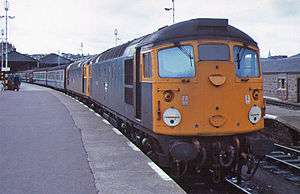 |
| 26/1 | none[21] | 11/6A | D5320-D5346[39] | 1958[43] | 27[43] | |||
| Class 27 | D12/3 | 12/6 | D5347-D5415[39] | 1961-62[21] | 69 | 1987 |  | |
| Class 28 | D12/1 | 12/5 | D5700-D5719 | 1958-59[36] | 20 | 1967-69 |  | |
| Class 29 | N/A | 13/4 | D61.. | 1965-1967[21] | 20 | 1969-71 | .jpg) | |
| Class 30 & 31 | D13/1, D14/2 | 14/2 | D5500-D5699, D5800-D5862 | 1957[36]-62[39] | 263 plus 81 conversions | still in use | ||
Type 3 locomotives: 1500–1999hp
| CLASS | Pre-TOPS numbers |
Introduced | Quantity | Withdrawn | Image | ||
|---|---|---|---|---|---|---|---|
| TOPS | 1955 | 1962 | |||||
| Class 33 | D15/1 | 15/6 | D6500—D6585[21][39] | 1960-62 [44] | 98[44] | still in use (with West Coast Railway Company)[24] |  |
| D15/2 | 15/6A | D6586-D6597[21][39] | |||||
| Class 35 (Hymek[45]) | D17/2 | 17/7 | D7000–D7100[5] | 1961-64[46] | 101[46] | 1971-1975[47] | |
| Class 37 | D17/1 | 17/3 | D6600-D6608 D6700-D6999[39] |
1960-65[48] | 309[48] | still in use[24] |  |
| Class 38 | 1980s (Proposed) | Never Built | |||||
| D16/1 | 16/8 | 10000-10001[21] | 1947-48[49] | 2[49] | 1963 1966[49] | 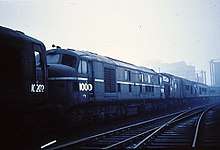 | |
| D16/2 | 16/9 | 10201-10203[21] | 1950 (2) 1954 (1)[36] | 3[36] | 1963 |  | |
Type 4 locomotives: 2000–2999hp
| CLASS | 1957 numbers | Built | Quantity | Withdrawn | Image | ||
|---|---|---|---|---|---|---|---|
| TOPS | 1955[21] | 1962[21] | |||||
| 10100 | 1950 | 1 | 1958 | ||||
| Class 40 | D20/1 | 20/3 | D200-D399[39] | 1958-62[39][39] | 200 | 1967 (1) 1975-85[50] |
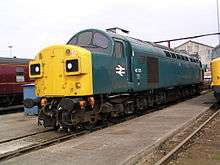 |
| Class 41 (I) (Warship[51]) | D20/2 | 20/4 | D600-D604[39] | 1958-59[46] | 5[46] | 1967[46] | _'Warship'_Diesel-hydraulic_on_an_Up_express._geograph-2392198-by-Ben-Brooksbank.jpg) |
| Class 41 (II) | N/A | 1972[5] | 2[5] | 1982 |  | ||
| Class 41 (III) | N/A | 1990s (Proposed) | Never Built | ||||
| Class 42 (Warship) | D22/1 | 22/1 | D800-D832, D866-D870[5] |
1958-61[5] | 38[46] | 1968-72[46] |  |
| Class 43 (I) (Warship) | D22/2 | 22/2 | D833-D865[5] | 1960-62 | 33 | 1969-1971 | 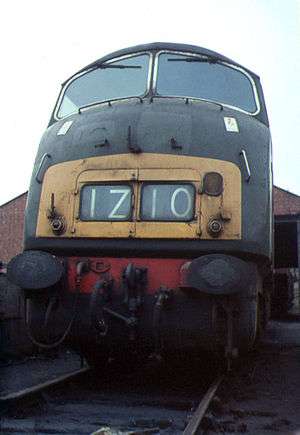 |
| Class 43 (II) | N/A | 1975-82[50] | 197[50] | Still in use[24] | |||
| Class 44 (Peak[52]) | D23/1 | 23/1 | D1-D10[5] | 1959-60 | 10 | 1976-81 |  |
| Class 45 | D25/1 | 25/1 | D11-D137[39] | 1960-63[39] | 127 | 1981-89[50] |  |
| Class 46 | N/A | 25/1A | D138-D193[39] | 1961[39] | 56 | 1977-84 |  |
| Class 47 | N/A | 27/2 | D1100-D1111, D1500-D1999[39] |
1962-68[39] | 512 | still in use[24] | |
| Class 48 | N/A | 27/2 | D1702-D1706. | 1965-66[39] | 5 | 1990-91[24] | 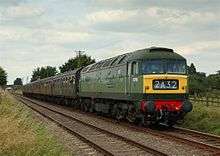 |
| Class 50 | N/A | 27/3 | D400-D449[39] | 1967-68[39] | 50[39] | 1987-94 | 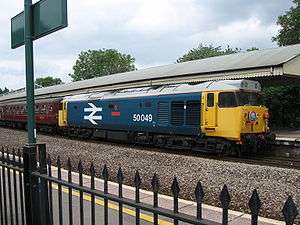 |
| Class 52 (Western[53]) | D27/1 | 27/1 | D1000-D1073[5] | 1961-1964 | 74 | 1973-77 |  |
| Class 53 Falcon[54] | ? | ? | D0280, later D1200 | 1961 | 1 | 1975 | _at_King's_Cross_station%2C_London.jpg) |
| Class 57 | N/A | 1965-67 Rebuilt: 1997-2004[24] | 33[24] | still in use[24] |  | ||
Type 5 locomotives: over 3000hp
| CLASS | 1957 numbers | Built | Quantity | Engine | Withdrawn | Image | ||
|---|---|---|---|---|---|---|---|---|
| TOPS | 1955[21] | 1962[21] | ||||||
| Class 51 | N/A | 1960s (Proposed) | Never Built | |||||
| Class 55 (Deltic[55]) | D33/1 | 33/1 | D9000-D9021 | 1961-62[25] | 22[25] | 2 x 1650 hp | 1980-82 |  |
| Class 56 | N/A | 1976-84[56] | 135[56] | 3250 hp | still in use (3 in Hungary[24]) |
 | ||
| Class 58 | N/A | 1983-87[50] | 50[50] | 3300 hp | 1999-2002 (some still in use in France (23) and Spain (13)[24]) |
|||
| Class 59 | N/A | 1985-95[57] | 15[57] | 3300 hp | still in use[24] | |||
| Class 60 | N/A | 1989-93[57] | 100[57] | 3100 hp | still in use[24] | 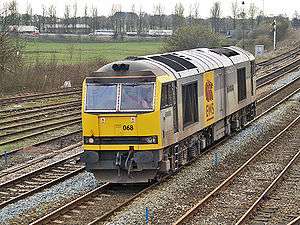 | ||
| Class 62 | N/A | 1990s (Proposed) | Never Built | |||||
| Class 65 | N/A | Never Built | ||||||
| Class 66 | N/A | 1998-2015[24] | 446[24] | 3300 hp | still in use[24] | |||
| Class 67 | N/A | 1999-2000[57] | 30[57] | 3200 hp | still in use[24] |  | ||
| Class 68 | N/A | 2013-2017[58] | 34[59][58] | 3300 hp | still in use[58][60] |  | ||
| Class 70 | N/A | 2009-17 | 37 | 3300 hp | still in use |  | ||
Electric locomotives
DC electric locomotives
| TOPS class | pre-TOPS class | Built | Quantity | Withdrawn | Image |
|---|---|---|---|---|---|
| Class 70 | 1941 1945 1948 | 3 | 1968 | 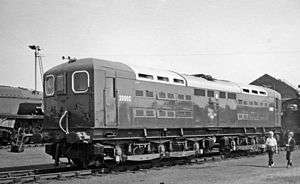 | |
| Class 71 | HA | 1958-60 | 24 | 1976-77 | |
| Class 73[lower-greek 1] | JA or JB | 1962 1965-67 | 49 | still in use |  |
| Class 74[lower-greek 1] | HB | 1958–60 Rebuilt 1967–1968 | 10 | 1976-1977 | |
| Class 75 | 1960s (Proposed) | Never Built | |||
| Class 76 | EM1 | 1941 (prototype) 1950-53 | 58 | 1970 (prototype) 1981 |
|
| Class 77 | EM2 | 1953-54 | 7 | 1968 | |
| EB1/EF1 (26502-26511) |
1914-1919 | 10 | 1950-1951 1964 |
||
| EE1 (26600) |
1922 | 1 | 1950 (never used) | ||
| ES1 (26500-26501) |
1903-1904 | 2 | 1964 |
AC electric locomotives
| TOPS class | pre-TOPS class | Built | Quantity | Withdrawn | Image |
|---|---|---|---|---|---|
| Class 80 | 1951 rebuilt 1958 | 1 | 1968 | ||
| Class 81 | AL1 | 1959–1964 | 25 | 1968 (2) 1971 (1) 1983-91 |
 |
| Class 82 | AL2 | 1960-62 | 10 | 1969 (1) 1971 (1) 1983 (6) 1987 (2) |
|
| Class 83 | AL3 | 1960-62 | 15 | 1975 (1) 1978 (1) 1983 (10) 1989 (3) |
|
| Class 84 | AL4 | 1960-61 | 10 | 1979-80 | |
| Class 85 | AL5 | 1961-64 | 40 | 1981-92 | 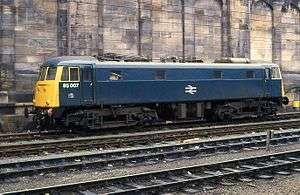 |
| Class 86 | AL6 | 1965-66 | 100 | 2002-date still in use (with Freightliner and in Bulgaria and Hungary). |
|
| Class 87 | 1973-75 | 36 | 2003; some still in use (in Bulgaria). |
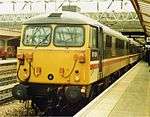 | |
| Class 88 (I) | 1983-87 (planned) | Never Constructed | |||
| Class 88 (II)[lower-greek 1] | 2015-16 | 10[61] | still in use |  | |
| Class 89 | 1986 | 1 | 2001 | ||
| Class 90 | 1987-90 | 50 | still in use | 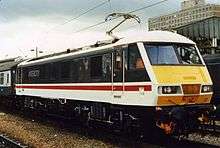 | |
| Class 91 | 1988-91 | 31 | still in use | ||
| Class 92 | 1993-96 | 46 | still in use |  | |
| Class 93 | 1992-95 (planned) | 30 (planned) | Never Constructed | .jpg) |
Miscellaneous locomotives
| Type | Class / number(s) | Information | Image |
|---|---|---|---|
| Channel Tunnel | Class 22 | SNCF Class BB 22200 class dual voltage electric locomotives used for freight duties through the Channel Tunnel by Railfreight Distribution during 1994-95, prior to the availability of the dedicated Class 92 locomotives. Allocated as Class 22 under TOPS. | 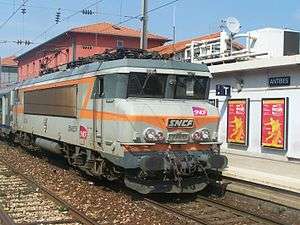 |
| Class 9000 | Dedicated locomotives used only on Eurotunnel Shuttle services through the Channel Tunnel between Foklestone & Calais. No TOPS classification. | 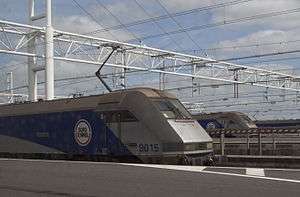 | |
| Class 0001 | Diesel-electric locomotives used for rescue purposes on the Channel Tunnel network. Classed as 21/9 under TOPS | 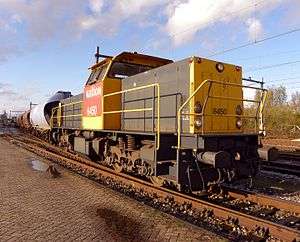 | |
| Class 0031 | Diesel locomotives used for maintenance purposes by Eurotunnel on the Channel Tunnel network. No TOPS classification | ||
| Departmental | Class 97 | General departmental locomotives, used for special or engineering duties. Were therefore of many different classes, lumped together for numbering purposes. Forty-seven locomotives allocated Class 97 numbers, including five in subclass 97/6. | 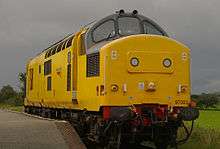 |
| Class 97/6 | Five diesel shunting locomotives purpose-built for departmental duties in 1953 (number 97650) and 1959 (numbers 97651-654). Withdrawn 1987-2005. | 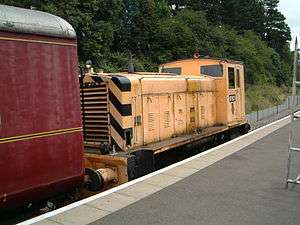 | |
| Various Pre-TOPS Departmental Locomotives | |||
| Steam | Class 98 | Used to cover all steam locomotives used on the mainline in Britain. Had particular usage for the three Vale of Rheidol Railway steam locomotives that remained in BR's ownership after the end of mainline steam traction in August 1968, and numbered 98007-98009. Also used for privately owned steam locomotives registered to run on the mainline since 1971, with numbers allocated in the following way:
|
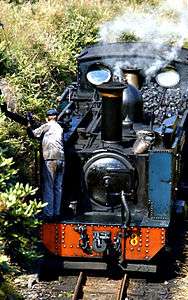 |
| Petrol | 15097-15099 | Petrol powered locomotives built by Simplex, introduced 1919-1925 by the LNER, and subsequently inherited by BR | |
| Gas turbine | 18000 | Prototype mainline gas turbine locomotive built for BR in 1949 by Brown Boveri. Had been ordered by GWR in 1940, but construction was delayed due to World War II. | 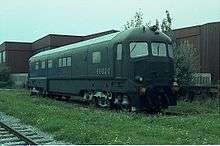 |
| 18100 | Prototype mainline gas turbine locomotive built for BR in 1951 by Metropolitan-Vickers. Had been ordered by the GWR in the 1940s, but construction was delayed due to World War II. | ||
Class 99
When British Rail implemented the TOPS system for managing their operating stock, ships capable of carrying rail vehicles were incorporated into the system as Class 99. In order to circumvent restrictions of the application software, these ships were entered on TOPS as locomotives, 'hauling' the trains which they carried on board.
Builders' demonstrators
These were locomotives built and owned by private firms, but used by British Rail to test them.
| Locomotive | Builder | Year | Fate | Image |
|---|---|---|---|---|
| D0226 & D0227 | English Electric | 1956 | D0226 preserved D0227 scrapped |
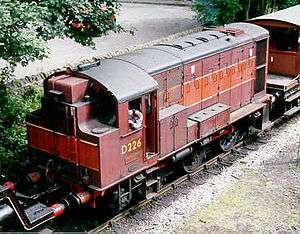 |
| D0260 Lion | BRCWC | 1962 | Scrapped in 1963 | |
| D0280 Falcon See Class 53, above | Brush Traction | 1961 | Scrapped 1976 | _at_King's_Cross_station%2C_London.jpg) |
| D9998 See Class D2/11, above | Brush Traction | 1958 | ? | |
| DHP1 | Clayton | 1965 | ? | |
| DP1 Deltic | English Electric | 1955 | Withdrawn 1961, preserved |
|
| DP2 | English Electric | 1962 | Scrapped 1967 | 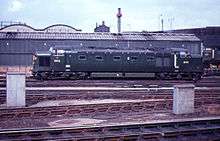 |
| GT3 (Gas turbine) | English Electric | 1961 | Scrapped 1966 | |
| HS4000 Kestrel | Brush Traction | 1968 | Scrapped 1989 |  |
| Janus | Yorkshire Engine Company | 1956 | Sold to Appleby-Frodingham Steel works; scrapped c.1982 | 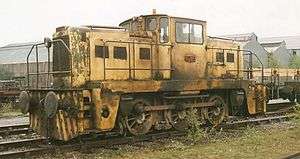 |
| Taurus | Yorkshire Engine Company | 1961 | Stripped 1962, scrapped 1965 |
Unbuilt locomotives
A number of TOPS class numbers were allocated to proposed locomotives, both diesel and electric, which for many reasons were not proceeded with.
See also
| Wikimedia Commons has media related to Locomotives of the United Kingdom. |
Footnotes
- ↑ Strickland (1983), p. 140.
- ↑ Strickland (1983), p. 47.
- 1 2 3 Williams & Percival (1962).
- 1 2 Strickland (1983), p. 45.
- 1 2 3 4 5 6 7 8 9 10 11 12 13 14 15 16 17 18 19 "The all-time guide to the UK Traction Classification System Part 2: Locomotives" (PDF). The RailwayCentre.org. 2006-05-02. Retrieved 2007-02-18.
- 1 2 Strickland (1983), p. 46.
- ↑ TRC - Classification: Part 2 (2006).
- ↑ Strickland (1983), p. 44–45.
- ↑ Strickland (1983), p. 43.
- ↑ Strickland (1983), p. 31–35.
- ↑ Strickland (1983), p. 35–39.
- 1 2 Strickland (1983), p. 40.
- 1 2 Strickland (1983), p. 41.
- ↑ Strickland (1983), p. 41–43.
- 1 2 Strickland (1983), p. 43–44.
- ↑ "D2708-D2780". TheRailwayCentre.com. Archived from the original on 7 February 2009. Retrieved 2007-02-22.
- ↑ "D2999". TheRailwayCentre.com. Retrieved 2017-12-01.
- ↑ "D2510-D2519". TheRailwayCentre.com. Archived from the original on 7 February 2009. Retrieved 2007-02-22.
- ↑ Strickland (1983), p. 46–47.
- ↑ "D2900-D2913". TheRailwayCentre.com. Archived from the original on 7 February 2009. Retrieved 2007-02-22.
- 1 2 3 4 5 6 7 8 9 10 11 12 13 14 15 16 17 18 19 20 "The all-time guide to the UK Traction Classification System Part 1: Pre TOPS class systems" (PDF). The RailwayCentre.org. 2006-05-02. Retrieved 2007-02-18.
- 1 2 Strickland (1983), p. 62.
- 1 2 3 4 5 Strickland (1983), p. 63.
- 1 2 3 4 5 6 7 8 9 10 11 12 13 14 15 16 17 18 19 20 21 22 Fox & Pritchard (2003).
- 1 2 3 Williams & Percival (1977).
- 1 2 Strickland (1983), p. 56.
- 1 2 "Class 10". The RailwayCentre.com. Retrieved 2007-03-03.
- ↑ Strickland (1983), p. 56–57.
- ↑ Strickland (1983), p. 48.
- ↑ Strickland (1983), p. 49.
- ↑ Strickland (1983), p. 51–52.
- ↑ Strickland (1983), p. 65–68.
- 1 2 3 "Ivatt 800hp Diesel Electric Locomotive". Southern Email Group. 2004-08-10. Retrieved 2007-02-17.
- ↑ "Recognition and Equipment information: Class 15". The RailwayCentre.com. Retrieved 2007-02-17.
- 1 2 3 4 The Railway Center. "Traction Data - Class 16". The RailwayCentre.com. Retrieved 2017-11-19.
- 1 2 3 4 5 6 7 8 9 Casserley (1962).
- 1 2 3 4 "Recognition and Equipment information: Class 17". The RailwayCentre.com. Retrieved 2007-02-17.
- ↑ "Class 20". The RailwayCentre.com. Retrieved 2007-02-17.
- 1 2 3 4 5 6 7 8 9 10 11 12 13 14 15 16 17 18 19 20 21 22 23 24 Marsden (1983).
- 1 2 John Daniel (2006-02-19). "D6300 class introduction". The Western Region Archive. Retrieved 2007-02-17.
- ↑ "Class 25 Withdrawals: The first fifty withdrawals (May 1971 - October 1980)". British Railways Sulzer Type 2. Retrieved 2007-02-17.
- ↑ "The last year of the Class 25's: March 1986 - March 1987". British Railways Sulzer Type 2. Retrieved 2007-02-17.
- 1 2 3 4 5 "A Brief History of British Railways Class 26". Centre of Locomotion Numerology. 8 February 1997. Archived from the original on 18 December 2006. Retrieved 17 February 2007.
- 1 2 Chapman (2007).
- ↑ Ian Allan (1969), p. 42.
- 1 2 3 4 5 6 7 Reed (1974).
- ↑ Andy Coward (30 January 2008). "Hymeks: The big class with a short life". Rail. UK: Bauer Media (584): 56–59. ISSN 0953-4563.
- 1 2 "Rolling stock : Class 37 English Electric". thejunction.org.uk. 2006-08-17. Retrieved 2007-02-14.
- 1 2 3 Hunt (2005).
- 1 2 3 4 5 6 Wood (1989).
- ↑ Marsden (2011).
- ↑ Ian Allan (1969), p. 5.
- ↑ Ian Allan (1969), p. 13.
- ↑ British Railways Locomotives and Other Motive Power: Combined Volume. London: Ian Allan Publishing. 1971. p. 17. ISBN 0-7110-0242-8.
- ↑ Ian Allan 1969, p. 51
- 1 2 "Class 56 Locomotive Information". Class 56 Photo Gallery. 2003-02-08. Retrieved 2007-02-17.
- 1 2 3 4 5 6 Fox, Webster & Hall (2000).
- 1 2 3 Railways Today (5 January 2012). "DRS orders 15 Vossloh Eurolight locomotives". Railways Today.
- ↑ "Brand new locomotive hauled trains for TPE". Rail Magazine. 23 May 2016.
- ↑ "Additional Class 68s for Beacon Rail / DRS". Mainline Diesels. 29 April 2014.
- ↑ "DRS orders 10 electro-diesel locomotives from Vossloh".
References
- Casserley, H. C. (1962). Observer's Book of Railway Locomotives of Britain. Observer's pocket series #23 (Revised ed.). London: Frederick Warne.
- Chapman, Stephen (2007). "British Rail Diesels: The "Crompton" (Class 33)". Retrieved 2007-02-14.
- Fox, Peter; Pritchard, Robert (2003). British Railway Pocket Book No. 1: Locomotives. Sheffield: Platform 5. ISBN 978-1-9023-3626-8. OCLC 655364009.
- Fox, Peter; Webster, Neil; Hall, Peter (2000). British Rail Motive Power Combined Volume 2000. Sheffield: Platform 5. ISBN 1-902336-13-5.
- Hunt, David (2005). LMS locomotive Profiles Vol. 9: Main Line Diesel-Electrics Nos. 10000 and 10001. Wild Swan Publications. ISBN 1-905184-04-2.
- Ian Allan (1969). British Railways Locomotives and Other Motive Power: Combined Volume. London: Ian Allan Publishing. ISBN 0-7110-0112-X.
- Marsden, Colin J. (1983). British Rail Motive Combined Volume 1983. Shepperton: Ian Allan Publishing. ISBN 0-7110-1284-9.
- Marsden, Colin J. (2011). Diesel and Electric Locomotive Recognition Guide. Ian Allan Publishing. ISBN 978-0-7110-3637-6.
- TRC - Classification: Part 2 (2006-05-02). "The all-time guide to the UK Traction Classification System Part 2: Locomotives" (PDF). The RailwayCentre.org. Retrieved 2007-02-18.
- Reed, Brian (1974). Diesel-Hydraulic Locomotives of the Western Region. David and Charles. ISBN 0-7153-6769-2.
- Strickland, David C. (September 1983). Locomotive Directory: Every Single One There Has Ever Been. Camberley, Surrey: Diesel and Electric Group. ISBN 978-0-9063-7510-5. OCLC 16601890.
- Williams, Alan; Percival, David (1962). British Rail Locomotives Combined Volume 1962. London: Ian Allan Publishing.
- Williams, Alan; Percival, David (1977). British Rail Locomotives and Multiple-Units including Preserved Locomotives 1977. London: Ian Allan Publishing. ISBN 0-7110-0751-9.
- Wood, Roger (January 1989). British Rail Motive Power Combined Volume 1989. London: Ian Allan Publishing. ISBN 0-7110-1849-9.